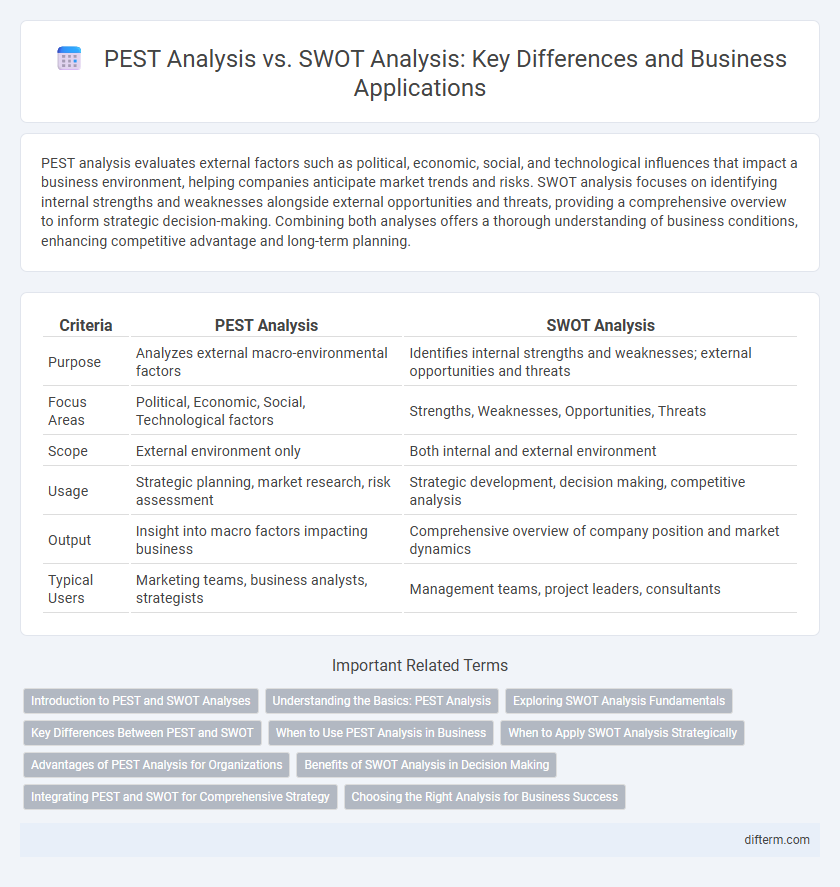PEST analysis evaluates external factors such as political, economic, social, and technological influences that impact a business environment, helping companies anticipate market trends and risks. SWOT analysis focuses on identifying internal strengths and weaknesses alongside external opportunities and threats, providing a comprehensive overview to inform strategic decision-making. Combining both analyses offers a thorough understanding of business conditions, enhancing competitive advantage and long-term planning.
Table of Comparison
| Criteria | PEST Analysis | SWOT Analysis |
|---|---|---|
| Purpose | Analyzes external macro-environmental factors | Identifies internal strengths and weaknesses; external opportunities and threats |
| Focus Areas | Political, Economic, Social, Technological factors | Strengths, Weaknesses, Opportunities, Threats |
| Scope | External environment only | Both internal and external environment |
| Usage | Strategic planning, market research, risk assessment | Strategic development, decision making, competitive analysis |
| Output | Insight into macro factors impacting business | Comprehensive overview of company position and market dynamics |
| Typical Users | Marketing teams, business analysts, strategists | Management teams, project leaders, consultants |
Introduction to PEST and SWOT Analyses
PEST Analysis examines external macro-environmental factors--Political, Economic, Social, and Technological--that impact business strategy and decision-making. SWOT Analysis evaluates internal Strengths and Weaknesses alongside external Opportunities and Threats to provide a comprehensive overview of organizational positioning. Both frameworks are essential for strategic planning, with PEST focusing on external influences and SWOT offering an integrated internal-external perspective.
Understanding the Basics: PEST Analysis
PEST Analysis examines external macro-environmental factors--Political, Economic, Social, and Technological--that impact business operations and strategic planning. It helps organizations identify opportunities and threats by analyzing market trends, regulatory changes, and technological advancements. Unlike SWOT Analysis, which includes internal factors, PEST offers a focused evaluation of external influences critical for long-term business sustainability.
Exploring SWOT Analysis Fundamentals
SWOT analysis identifies internal strengths and weaknesses alongside external opportunities and threats, offering a comprehensive framework for strategic planning. Unlike PEST analysis, which examines political, economic, social, and technological external factors, SWOT integrates both internal and external elements to assess organizational capabilities and market conditions. This dual focus enables businesses to leverage strengths, address weaknesses, capitalize on opportunities, and mitigate risks effectively.
Key Differences Between PEST and SWOT
PEST analysis assesses external macro-environmental factors including Political, Economic, Social, and Technological influences that impact business strategy, while SWOT analysis evaluates internal strengths and weaknesses alongside external opportunities and threats. PEST provides a broad external perspective vital for strategic planning and market entry, whereas SWOT integrates both internal and external insights to identify actionable business priorities. Understanding these differences helps organizations tailor their decision-making processes to improve competitive advantage and anticipate market changes.
When to Use PEST Analysis in Business
PEST Analysis is essential for identifying external macro-environmental factors affecting business strategy, such as Political, Economic, Social, and Technological influences. It is most effective during market entry planning, long-term strategic development, and risk assessment when understanding external threats and opportunities is critical. Businesses use PEST Analysis to anticipate industry trends and regulatory changes before conducting internal evaluations like SWOT Analysis.
When to Apply SWOT Analysis Strategically
SWOT analysis is strategically applied during internal assessments to identify strengths and weaknesses relative to market opportunities and threats, enhancing decision-making for business growth. It proves most effective when organizations need to align resources with competitive advantages or address vulnerabilities in rapidly changing industries. This method supports targeted strategic planning by integrating internal capabilities with external environmental factors.
Advantages of PEST Analysis for Organizations
PEST analysis offers organizations a comprehensive evaluation of external macro-environmental factors, such as political, economic, social, and technological influences, enabling proactive strategic planning. It helps businesses identify emerging market trends, regulatory changes, and potential risks before they impact operations, fostering resilience and adaptability. Incorporating PEST insights supports informed decision-making and long-term competitive advantage by aligning organizational strategies with external environmental shifts.
Benefits of SWOT Analysis in Decision Making
SWOT analysis provides clear insights into a company's internal strengths and weaknesses while identifying external opportunities and threats, enabling more informed strategic decision-making. It facilitates the alignment of resources with key business objectives by highlighting competitive advantages and potential risks. This comprehensive overview supports prioritization and resource allocation, improving the overall effectiveness of business planning and risk management.
Integrating PEST and SWOT for Comprehensive Strategy
Integrating PEST and SWOT analysis offers a comprehensive approach to strategic planning by combining external macro-environmental factors with internal capabilities and weaknesses. PEST analysis evaluates Political, Economic, Social, and Technological influences, identifying opportunities and threats, while SWOT analysis assesses Strengths, Weaknesses, Opportunities, and Threats within the company. Together, these frameworks enable businesses to align internal resources with external market conditions, optimizing decision-making and enhancing competitive advantage.
Choosing the Right Analysis for Business Success
PEST analysis evaluates external factors--Political, Economic, Social, and Technological--that impact a business environment, providing insights for strategic planning in volatile markets. SWOT analysis identifies internal Strengths and Weaknesses alongside external Opportunities and Threats, offering a comprehensive framework for decision-making and resource allocation. Selecting between PEST and SWOT depends on whether the focus is on external environmental scanning or internal capability assessment for achieving competitive advantage.
PEST Analysis vs SWOT Analysis Infographic

 difterm.com
difterm.com